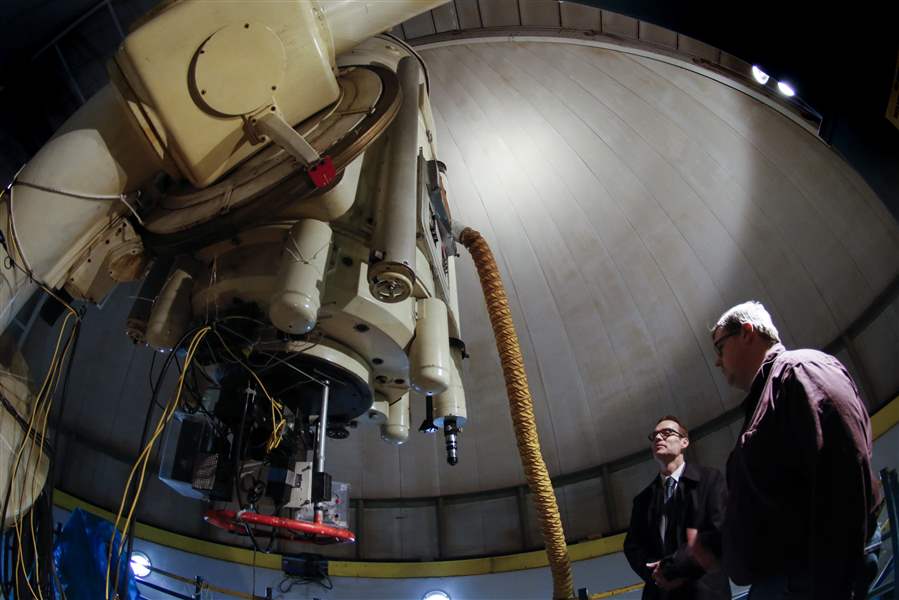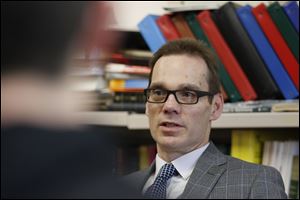
New space telescope expected to make Hubble 'look simple'
2/23/2018
Ken Sembach, left, speaks with Noel Richardson, Ritter Observatory researcher, as they look over the telescope at the University of Toledo, Thursday, Feb.22, 2018. Ken Sembach, head of the Baltimore-based Space Telescope Science Institute that operates NASA's Hubble Telescope, was visiting with students before a speech Thursday night.
The Blade/Andy Morrison
Buy This Image
Imagine an $8.8 billion telescope as big as a tennis court capturing images of outer space never before seen by mankind while it is a million miles from Earth, four times the distance between this planet and the moon, and working in temperatures more than 400 degrees below zero.
Welcome to the next frontier in astrophysics, one that’s coming in 2019 and has a couple of Ohio connections.

Ken Sembach is the head of the Baltimore-based Space Telescope Science Institute, which operates NASA's Hubble Telescope, was visiting with students before a speech Thursday night.
Ken Sembach, director of the Baltimore-based Space Telescope Science Institute, which operates NASA’s Hubble Space Telescope, said his institute will soon launch the James Webb Space Telescope, which he predicts will blow people away with mind-boggling images of stars and galaxies billions of light years from Earth.
Often referred to by the abbreviation JWST, the Webb telescope has been in the making for years.
Originally planned for blast-off this October, it will be launched in early to mid-2019 by a European Space Agency Ariane 5 rocket.
The launch will be from Arianespace's ELA-3 launch complex at European Spaceport, near Kourou, French Guiana. A site near the equator was chosen because the spin of the Earth can give an additional push there, NASA said.
Earth’s surface at the equator moves at 1,038 mph, according to the space agency’s calculations.
“We have to get it right,” Mr. Sembach said, telling an audience of more than 100 people inside the University of Toledo’s Wolfe Hall on Thursday night he is unfazed by and completely supports NASA’s decision to wait until 2019 so it can do more testing.
The JWST will be 100 times more powerful than Hubble and will make the most famous telescope to date “look simple,” Mr. Sembach said earlier in the day.

Ken Sembach, left, speaks with Noel Richardson, Ritter Observatory researcher, as they look over the telescope at the University of Toledo, Thursday, Feb.22, 2018. Ken Sembach, head of the Baltimore-based Space Telescope Science Institute that operates NASA's Hubble Telescope, was visiting with students before a speech Thursday night.
His visit was the latest from a series of high-profile speakers UT is bringing to campus as part of a continuing effort to celebrate the 50th anniversary of its Ritter Astrophysics Research Center. It included an hour-long chat with students, and a tour of the Ritter facility.
Mr. Sembach began his evening presentation by dazzling people with images captured by Hubble, which was launched into low Earth orbit in 1990.
He then overlaid those images with ones of how infrared capabilities and super-sharp resolution of the JWST will likely be a game changer, showing astronomers where millions of more distant stars exist in areas where only dust can now be seen through Hubble’s lenses.
Hubble was designed to pick up ultra-violet light, not infrared.
“We need to study wavelengths beyond Hubble’s capability,” Mr. Sembach explained.
The JWST also will extend that vision exponentially deeper into space than anyone’s ever seen, he said.
But Hubble’s not done, either.
Twenty-eight years later, it continues to be a low-orbit workhorse 350 miles above the Earth. It will work it in tandem with JWST, generating more images to complement those from the JWST, he said.
“It's really opened our eyes to what the solar system looks like,” Mr. Sembach said of Hubble, saying it went beyond expectations.
Astronomers learned there are likely more than 200 million galaxies in the universe, each with millions of stars. They also now estimate there are likely 10 times more galaxies they’re not even seeing yet, he said.
More importantly, they learned the physical appearance of stars change as galaxies age.
“We now know galaxies change with time,” Mr. Sembach said. “We didn't really know this before Hubble was launched. It was believed galaxies were static and should remain the same everywhere. They don't.”
As for those Ohio connections, here are a couple of big ones:
● The idea for Hubble — getting a high-powered telescope far above Earth’s atmosphere — came way back in 1946 when a Toledo-based astrophysicist, Lyman Spitzer, Jr., proposed building telescopes in space. As of 2018, more than 15,000 scientists have published papers with Hubble research.
● Materion Corp., which includes the former Brush Wellman, Inc., and other companies, provides the beryllium needed for the JWST to withstand temperatures of negative 400 degrees in deep space. The super tough polished metal is important to keep the telescope’s 18 mirrors from expanding and contracting, Mr. Sembach said.
According to the company’s website, scientists developing the JWST “decided beryllium was perfectly suited to this mission because of its strong, yet lightweight, properties and its ability to be polished — important characteristics when making high tech mirrors.”
The JWST’s beryllium was mined in Utah and refined in Ohio, Mr. Sembach said.
By the mid-2020s, NASA hopes to enter yet another frontier by bringing the best of Hubble and JWST together into a single device called the Wide-Field Infrared Survey Telescope, or WFIRST.
That project was announced in 2016. It is to provide the deep-space, infrared capabilities of JWST with a vision that is 100 times wider than Hubble, Mr. Sembach said.
The JWST is named after NASA’s second administrator, James Webb, who ran the space agency from Feb. 14, 1961, to Oct. 7, 1968. Mr. Webb received an honorary degree at the dedication of UT’s Ritter facility on Oct. 13, 1967.
Contact Tom Henry at thenry@theblade.com, 419-724-6079, or via Twitter @ecowriterohio.